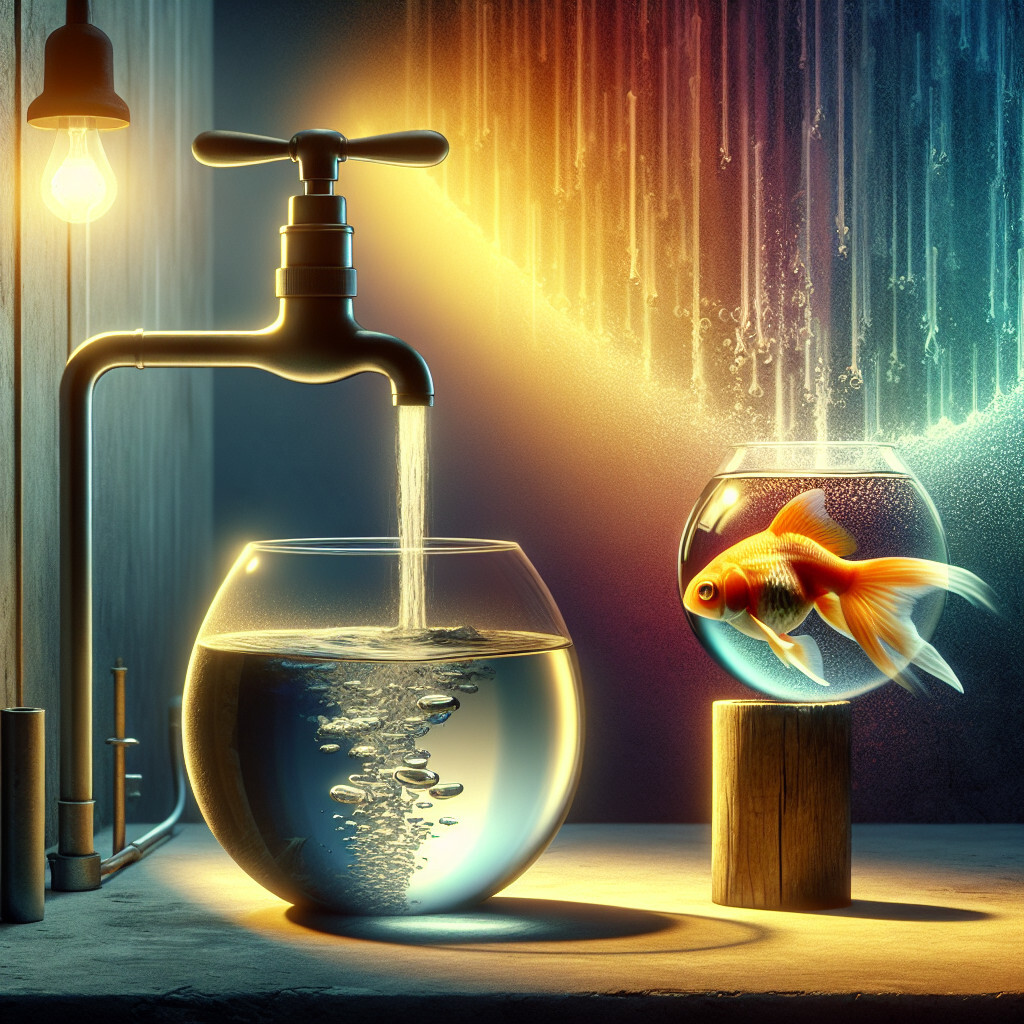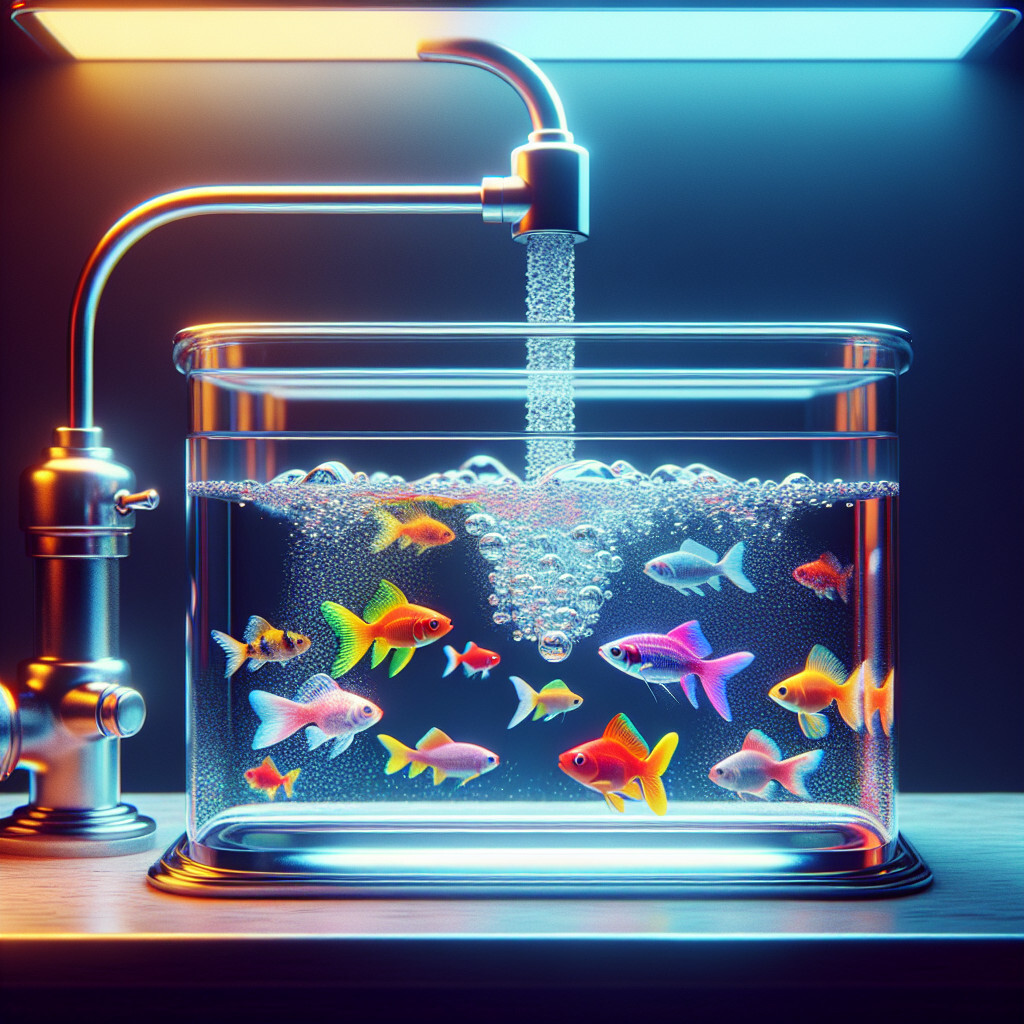-
Table of Contents
“Tap Water: Unfiltered Risk to Fish Life.”
Introduction

Tap water can potentially harm or even kill fish due to the presence of chemicals such as chlorine and chloramine, which are commonly used in water treatment processes to eliminate bacteria and other harmful microorganisms. These chemicals, while safe for human consumption, can be toxic to fish. Therefore, it’s crucial to treat tap water properly before using it in a fish tank or aquarium.
Understanding the Impact of Tap Water on Aquatic Life
The question of whether tap water can kill fish is one that has been asked by many aquarium enthusiasts and fish owners. The answer, however, is not as straightforward as one might think. While tap water is not inherently lethal to fish, it can indeed be harmful and even fatal under certain circumstances. This is primarily due to the various chemicals and substances that are often present in tap water, which can have a significant impact on aquatic life.
One of the most common substances found in tap water is chlorine. This chemical is routinely added to municipal water supplies as a disinfectant, to kill bacteria and other harmful microorganisms. While this makes the water safe for human consumption, it can be toxic to fish. Chlorine can damage the gills of fish, impairing their ability to breathe. It can also disrupt their osmoregulatory function, which is the process by which they maintain the balance of salts and water in their bodies. In severe cases, exposure to high levels of chlorine can lead to death.
Another substance that is often present in tap water is chloramine, a compound of chlorine and ammonia. Like chlorine, chloramine is used as a disinfectant in water treatment processes. However, it is more stable and longer-lasting than chlorine, which means it remains in the water for a longer period of time. This can be problematic for fish, as chloramine can cause similar health issues as chlorine, including gill damage and osmoregulatory disruption. Moreover, the ammonia component of chloramine can also be toxic to fish.
Heavy metals such as lead, copper, and zinc are also frequently found in tap water. These metals can accumulate in the bodies of fish, leading to a range of health problems. For instance, lead can cause neurological damage, while copper can harm the gills, liver, and kidneys. Zinc, on the other hand, can interfere with the digestion and metabolism of fish.
In addition to these substances, tap water can also contain various other chemicals and pollutants, depending on the source of the water and the methods used to treat it. These can include pesticides, pharmaceuticals, and industrial chemicals, all of which can be harmful to fish.
However, it’s important to note that not all tap water is harmful to fish. Many of these substances can be removed or neutralized by using water conditioners or dechlorinators, which are readily available in pet stores and aquarium supply shops. These products can detoxify harmful chemicals and make the water safe for fish.
Furthermore, the impact of tap water on fish can also depend on the species of fish. Some species are more tolerant of certain substances than others, and can survive in a wider range of water conditions. Therefore, it’s crucial for fish owners to research the specific needs and tolerances of their fish, and to test their water regularly to ensure it is safe.
In conclusion, while tap water can potentially be harmful to fish, it is not necessarily lethal. With the right precautions and care, it is possible to use tap water in aquariums without endangering the lives of the fish. However, it’s always important to be aware of the potential risks and to take steps to mitigate them.
The Hidden Dangers of Tap Water to Fish
Tap water, a seemingly harmless substance, can pose a significant threat to the health and survival of fish. This is due to the various chemicals and substances that are often present in tap water, which can be harmful or even lethal to fish. The hidden dangers of tap water to fish are often overlooked, leading to unfortunate consequences for these aquatic creatures.
One of the primary concerns with tap water is the presence of chlorine. This chemical is commonly used in water treatment processes to kill bacteria and other harmful organisms, making the water safe for human consumption. However, for fish, chlorine can be deadly. It can damage their gills and skin, leading to respiratory distress and other health problems. Even small amounts of chlorine can be harmful to fish, and prolonged exposure can result in death.
In addition to chlorine, tap water can also contain heavy metals such as copper and lead. These metals can accumulate in the bodies of fish, causing a range of health issues including organ damage and reproductive problems. Copper, in particular, is highly toxic to fish and can cause symptoms such as loss of balance, rapid breathing, and even death.
Another potential danger of tap water is the presence of chloramines. These compounds are formed when chlorine reacts with ammonia, and they are often used in water treatment as a longer-lasting disinfectant. While chloramines are less volatile than chlorine, they are more difficult to remove from water and can be harmful to fish. They can cause similar problems as chlorine, including damage to the gills and skin.
Furthermore, tap water can also contain various other chemicals and substances that can be harmful to fish. These include pesticides, pharmaceuticals, and personal care products that can end up in the water supply through runoff and wastewater. These substances can have a range of negative effects on fish, including hormonal disruption, behavioral changes, and increased susceptibility to disease.
The pH level of tap water can also pose a threat to fish. Fish require a specific pH level to thrive, and changes in this level can cause stress and health problems. Tap water often has a pH level that is too high or too low for fish, which can lead to issues such as reduced growth, decreased resistance to disease, and in severe cases, death.
In conclusion, while tap water may appear safe and harmless, it can pose a significant threat to the health and survival of fish. The presence of chlorine, heavy metals, chloramines, and other harmful substances, as well as the potential for inappropriate pH levels, make tap water a risky choice for fish. Therefore, it is crucial to treat and condition tap water before using it in a fish tank or pond. This can involve using a water conditioner to neutralize harmful chemicals, testing the water to ensure it is safe, and adjusting the pH level if necessary. By taking these steps, fish owners can help ensure the health and longevity of their aquatic pets.
Will Tap Water Kill Your Aquarium Fish? Unveiling the Truth
The question of whether tap water can kill your aquarium fish is one that has been asked by many aquarium enthusiasts. The answer, however, is not as straightforward as one might think. While it is true that tap water can potentially harm or even kill your fish, this is not always the case. The impact of tap water on your fish largely depends on the quality of the water and the type of fish you have.
Tap water is treated with a variety of chemicals to make it safe for human consumption. One of these chemicals is chlorine, which is used to kill bacteria and other harmful organisms. While chlorine is safe for humans, it can be deadly for fish. Even small amounts of chlorine can damage the gills of a fish, making it difficult for them to breathe. Over time, this can lead to stress, illness, and even death.
However, not all tap water contains high levels of chlorine. The amount of chlorine in tap water can vary greatly depending on where you live. In some areas, the water may contain only trace amounts of chlorine, while in others, the levels may be much higher. Therefore, it is crucial to test your tap water for chlorine before using it in your aquarium. If the levels are too high, you can use a water conditioner to neutralize the chlorine.
Another factor to consider is the pH level of the tap water. Fish require a specific pH level to thrive, and this can vary depending on the species of fish. If the pH level of the tap water is too high or too low for your fish, it can cause stress and health problems. Again, it is important to test the pH level of your tap water and adjust it as necessary to match the needs of your fish.
In addition to chlorine and pH levels, tap water may also contain heavy metals, such as copper and lead, which can be toxic to fish. These metals can come from the pipes and plumbing in your home. While most tap water is treated to remove these metals, some may still remain. Therefore, it is a good idea to use a water conditioner that not only neutralizes chlorine but also detoxifies heavy metals.
In conclusion, while tap water can potentially harm or kill your aquarium fish, this is not always the case. The impact of tap water on your fish depends on the quality of the water and the specific needs of your fish. By testing your tap water and using a water conditioner, you can ensure that your tap water is safe for your fish. Remember, the health and well-being of your fish depend on the quality of the water in their environment. Therefore, it is essential to take the necessary steps to provide them with the best possible living conditions.
Exploring the Effects of Chlorinated Tap Water on Fish Health
The health and well-being of fish, particularly those kept in home aquariums, is a topic of great interest to many. One aspect that often raises questions is the suitability of tap water for fish. The concern arises from the fact that tap water is typically treated with various chemicals, most notably chlorine, to make it safe for human consumption. However, what is safe for humans is not always safe for fish. This article explores the effects of chlorinated tap water on fish health.
Chlorine is a common disinfectant used by water treatment facilities to kill bacteria and other harmful microorganisms in the water supply. While this makes tap water safe for humans to drink, it can be lethal to fish. Fish, unlike humans, absorb water directly through their gills, which means that any chemicals present in the water can easily enter their bloodstream. Chlorine, in particular, can cause damage to the gills and internal organs of fish, leading to serious health problems and even death.
The effects of chlorine on fish are not always immediate. In some cases, fish exposed to chlorinated water may appear normal for a time, only to suddenly become ill or die. This is because the damage caused by chlorine is often cumulative, building up over time until it reaches a critical level. Symptoms of chlorine poisoning in fish can include lethargy, loss of appetite, rapid breathing, and changes in color or behavior.
It’s important to note that not all tap water is equally harmful to fish. The level of chlorine in tap water can vary greatly depending on the source and treatment process. Some water treatment facilities use chloramine, a more stable compound of chlorine and ammonia, instead of pure chlorine. While chloramine is less toxic to fish than chlorine, it is also more difficult to remove from the water, making it a potential threat to fish health.
Fortunately, there are ways to make tap water safe for fish. One common method is to let the water sit out for 24 to 48 hours before adding it to the aquarium. This allows the chlorine to evaporate naturally. However, this method is not effective for removing chloramine. For water treated with chloramine, a chemical dechlorinator is needed. These products are readily available at pet stores and online, and they work by neutralizing both chlorine and chloramine.
Another option is to use bottled spring water or distilled water for your aquarium. These types of water are typically free of chlorine and other harmful chemicals, making them safe for fish. However, they can be more expensive than tap water and may not contain all the necessary minerals for fish health.
In conclusion, while tap water is generally safe for human consumption, it can be harmful or even lethal to fish due to the presence of chlorine and other chemicals. However, with proper treatment or the use of alternative water sources, it is possible to provide a safe and healthy environment for your fish. As always, it’s important to monitor your fish closely for any signs of distress and to consult with a professional if you have any concerns about their health.
Q&A
1. Question: Can tap water kill fish?
Answer: Yes, tap water can potentially kill fish due to the presence of chlorine and other harmful chemicals used to treat the water.
2. Question: How does tap water affect fish?
Answer: Tap water contains chlorine, chloramines, and heavy metals which can harm fish. These substances can damage fish’s gills and alter their pH balance, leading to stress, illness, or death.
3. Question: Can fish survive in tap water if it’s treated?
Answer: Yes, fish can survive in tap water if it’s treated with a water conditioner to neutralize harmful chemicals like chlorine and chloramines.
4. Question: What should I do to make tap water safe for my fish?
Answer: To make tap water safe for fish, you should treat it with a water conditioner or dechlorinator. This neutralizes harmful chemicals. Also, ensure the water is at an appropriate temperature and pH level for the specific type of fish.
Conclusion
In conclusion, tap water can potentially kill fish due to the presence of chlorine and other harmful chemicals used in water treatment processes. However, this can be prevented by treating the tap water with a dechlorinator before introducing fish.






